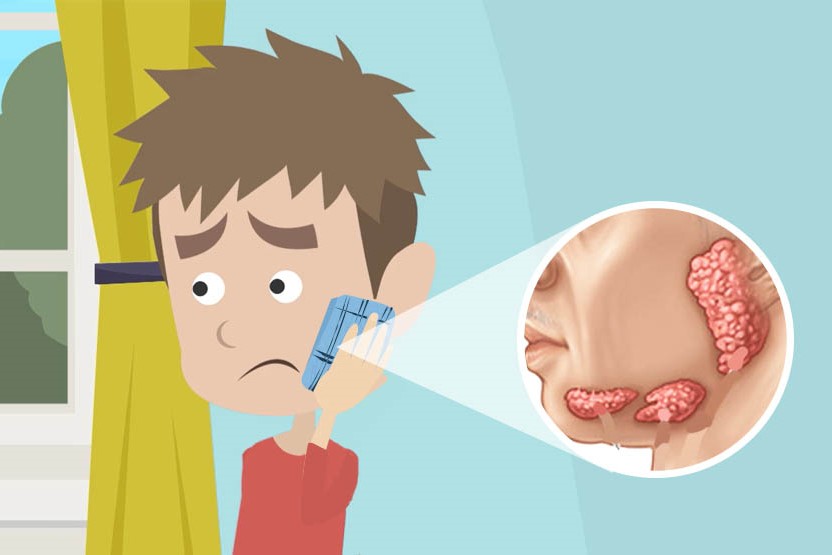
Parotitis: symptoms, treatment and prevention of mumps
Parotitis (popularly known as ‘mumps’) is an epidemic disease mainly affecting school-age children, caused by a paramyxovirus, typical of humans (there are no known cases of epidemic mumps in animals), which tends to heal spontaneously
Epidemiology of parotitis
In populations where vaccination is not carried out, the disease is epidemic, affecting 90% of subjects, who by the age of adolescence possess antibodies to the virus.
The preferred epidemic season is late winter and spring, with new epidemics every 2-5 years.
The vaccine’s efficacy is demonstrated by data from the USA, where, before vaccination was made compulsory, the incidence of epidemic mumps was 100-200 cases per 100,000 inhabitants; after the introduction of the vaccine in 1968, the incidence dropped to 1.1 cases per 100,000 people, a 97% decrease from the previous year, and the incidence fell to a record 1,640 cases in 1993 in the USA as a whole.
Mumps transmission and symptoms
Transmission occurs via saliva droplets emitted by coughing and sneezing, as with measles.
The incubation time is 18 days, with contagiousness beginning one week before the onset of symptoms and lasting up to 7-8 days after illness onset.
The onset of the disease is characterised by a mild fever, a feeling of malaise, headache and lack of appetite (symptoms entirely identical to many other viral diseases).
It is only after a few days that the characteristic enlargement of the major salivary glands, i.e. the parotids, on one or both sides manifests itself, and from this point onwards for the next 48 hours the contagiousness reaches its peak.
Adenitis is easily distinguishable from the usual submandibular adenitis because it fills the retro-mandibular groove (i.e. the swelling is behind the jaw and not underneath) and can raise the earlobe forward.
The minor, submandibular salivary glands may in some cases be affected and swell, although this is not the rule.
When the disease affects both parotids, the child presents a characteristic appearance, similar to a cat’s head, so much so that in some regions it is popularly referred to as ‘cat’s head’.
The enlargement of the parotids continues, accompanied by pain, for about 3 days, followed by the disappearance of the fever, swelling and pain, which is complete in 7 days.
Risks and complications related to parotitis
They are not uncommon, and involve first of all lymphocytic meningitis, which has an incidence of 15% among all cases of epidemic mumps: the symptoms are those of meningeal irritation (headache, nuchal rigidity, soporific state, vomiting) and appear 4-5 days after the onset of the disease, although in rare cases meningitis has been shown to take precedence over mumps itself.
The meningeal complication affects males far more often than females, for unknown reasons, but fortunately spontaneous recovery without neurological sequelae is the rule, after 6-7 days, although biochemical and morphological changes in the CSF may persist for up to 5 weeks.
A frequent complication in post-pubertal males is orchitis, or rather orchi-epididymitis, which occurs in 15%-30% of cases, due to viral replication in the seminiferous tubules.
Orchitis manifests itself one week after the onset of the disease, with a marked and painful swelling of the testicle, nausea, fever and headache.
Resolution occurs within 7 days, although testicular soreness may persist for weeks.
In 30% to 50% of cases, orchi-epididymitis may result in testicular atrophy, although sterility is very rare.
Other much less frequent complications are symptoms affecting various glands, from the pancreas to the thyroid or breast.
Treatment and cure of mumps
The only possible therapy is symptomatic: hydration, antipyretics, analgesics.
There is no fixed rule for the local treatment of the parotid swelling: some children get relief from cold compresses, others, strangely enough, find relief from the application of warm-humid compresses (the old grandmother’s remedy with camomile fried in oil).
As for orchitis, bed rest, scrotal support and cold compresses are necessary.
Prevention of mumps
The main point of prevention is the vaccination with live, attenuated virus, which is normally carried out at the same time as the measles and rubella vaccination, performed at 15 months, which confers 95% immunity, increased by the booster dose at 5 years.
Complications due to the vaccine, which are always present as with any other vaccine, are however much lower in frequency and severity than complications caused by the natural disease.
Read Also:
Emergency Live Even More…Live: Download The New Free App Of Your Newspaper For IOS And Android
Plaques In The Throat: How To Recognise Them
Lymphoma: 10 Alarm Bells Not To Be Underestimated
Non-Hodgkin’s Lymphoma: Symptoms, Diagnosis And Treatment Of A Heterogeneous Group Of Tumours
Lymphadenomegaly: What To Do In Case Of Enlarged Lymph Nodes
Sore Throat: How To Diagnose Strep Throat?
Sore Throat: When Is It Caused By Streptococcus?
Pharyngotonsillitis: Symptoms And Diagnosis
Tonsillitis: Symptoms, Diagnosis And Treatment
Paediatrics, What Is Alagille Syndrome?
What Are The Symptoms Of Hyperthyroidism?


